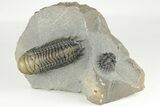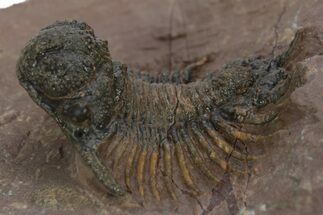This Specimen has been sold.
Large Acanthopyge Trilobite With Crotalocephalina - Atchana, Morocco
This is a 1.25" long lichid (Acanthopyge bassei) trilobite from the Lhandar Formation of Morocco. It maybe the largest specimen of this rare species I have seen and is impeccably prepared. Not only that but there is a beautiful, 3.2" long Crotalocephalina gibbus naturally associated with it on the rock. This is a fantastic association of two different genre of trilobites from Atchana, Morocco.
There is no restoration on Acanthopyge and about 3% shell restoration on the Crotalocephalina (mainly on head).
There is no restoration on Acanthopyge and about 3% shell restoration on the Crotalocephalina (mainly on head).
About Trilobites
Trilobites are an extinct class of marine arthropods that thrived for nearly 270 million years, from the early Cambrian to the end of the Permian period (around 521 to 252 million years ago). They are one of the most successful and diverse groups in the history of life, with over 25,000 described species spanning a wide range of sizes, shapes, and ecological niches. Known for their distinctive, segmented exoskeletons, trilobites provide invaluable insights into the evolutionary history of arthropods and the dynamics of ancient marine ecosystems.
Trilobites are an extinct class of marine arthropods that thrived for nearly 270 million years, from the early Cambrian to the end of the Permian period (around 521 to 252 million years ago). They are one of the most successful and diverse groups in the history of life, with over 25,000 described species spanning a wide range of sizes, shapes, and ecological niches. Known for their distinctive, segmented exoskeletons, trilobites provide invaluable insights into the evolutionary history of arthropods and the dynamics of ancient marine ecosystems.
SPECIES
Acanthopyge bassei & Crotalocephalina gibbus
LOCATION
Atchana, Morocco
FORMATION
Lhandar Formation
SIZE
Crotalocephalina 3.2", Acanthopyge 1.25"
CATEGORY
SUB CATEGORY
ITEM
#203005
We guarantee the authenticity of all of our specimens.
 Reviews
Reviews



















